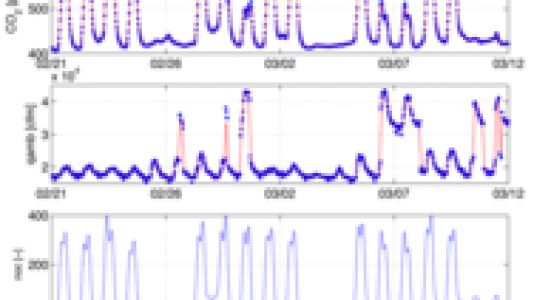
Estimating the number of occupants in a building at any given time is key for determining the heating and cooling loads as well as ventilation rates necessary to maintain comfort and air quality conditions. Real-time occupancy information also provides insights into occupant behavior (e.g., when do most occupants arrive and leave? when do we turn on the air conditioning system?) and can be used in emergency evacuation procedures (e.g., if a fire occurs, how many people need to be evacuated at 10 am vs. at 3 pm? how many if we have a big conference going on?). Numerous techniques for occupancy estimation exist in the market but they are highly expensive and often violate occupant privacy. Argonne researcher Victor Zavala has now developed a more cost-effective and less intrusive approach, based on moving horizon estimation (MHE). This approach infers occupancy signals from histories of carbon dioxide and air flow sensor measurements. “The painful reality is that we do not know how many people are in our buildings at any given time. The central air conditioning system overventilates these buildings, wasting huge amounts of energy and money,” Zavala says.
A key issue with MHE techniques is that they can lead to highly unstable estimates of occupancy because the occupancy estimation problem is infinite-dimensional and inherently ill-posed. In other words, sensor data are often insufficient to fully infer occupancy signals, which are continuous and highly dynamic functions of time. This ill-posedness is also known as “weak observability,” and regularization procedures are needed to mitigate it. Occupancy bounds (minimum and maximum estimates of people) are often used to regularize ill-posed MHE problems because they filter out regions of unrealistic occupancy levels (they add prior knowledge about the signals). Such constraints are insufficient, however, for estimating highly dynamic signals. To address this problem, Zavala further constrains the time-dependent signals to Fourier series expansions. These smoothing functions capture the inherent periodicity of occupancy and airflow signals commonly observed in buildings. The coefficients determining the amplitudes and frequencies of such functions are estimated by the MHE formulation, which is a nonlinear optimization problem.
“The MHE formulation regularized in this way can significantly reduce the occupancy signal volatility and sustain strong levels of sensor noise,” said Zavala. “The regularization approach effectively decreases the number of degrees of freedom in the estimation problem by an order of magnitude, thus preventing ill-posedness.”
To demonstrate his claims, Zavala conducted a couple of studies. For the first study, he assumed an occupancy profile with a peak occupancy of 275 during weekdays and 75 during weekends and used a physical model to compute the corresponding carbon dioxide concentrations and corrupted this signals with noise. He ran his MHE estimator with and without Fourier regularization to check how effectively both techniques could recover the occupancy signals from the carbon dioxide signals. The unregularized approach shows errors of less than 50 occupants 95% of the time, whereas the regularized approach yields errors of less than 10 occupants 95% of the time (an improvement of 80% in accuracy).
In addition to simulated studies, Zavala tested the performance of MHE using real sensor readings from the heating, ventilation, and air conditioning system of the Advanced Photon Source (APS) office building at Argonne National Laboratory. The results (see the figure on the right panel) show that the occupancy inferred by unregularized MHE varies strongly and in a manner inconsistent with typical occupancy behavior observed in this building. This volatility is significantly reduced through regularization, leading to more realistic estimates. Zavala was also able to validate that the peak number of occupants in the APS building is in the range of 350-400, which is a typical number reported by the building staff.
Zavala notes that the approach is useful for recovering weakly observable signals in many applications such as contaminant detection. He already has plans for his next steps. “We need to study different building models incorporating thermal and carbon dioxide balances and natural ventilation effects,” said Zavala. He is currently looking for additional funds to refine his studies.
For further information, see the full paper on the website:
Victor Zavala, Inference of building occupancy signals using moving horizon estimation and Fourier regularization, Journal of Process Control, in press http://www.sciencedirect.com/science/article/pii/S0959152413001893